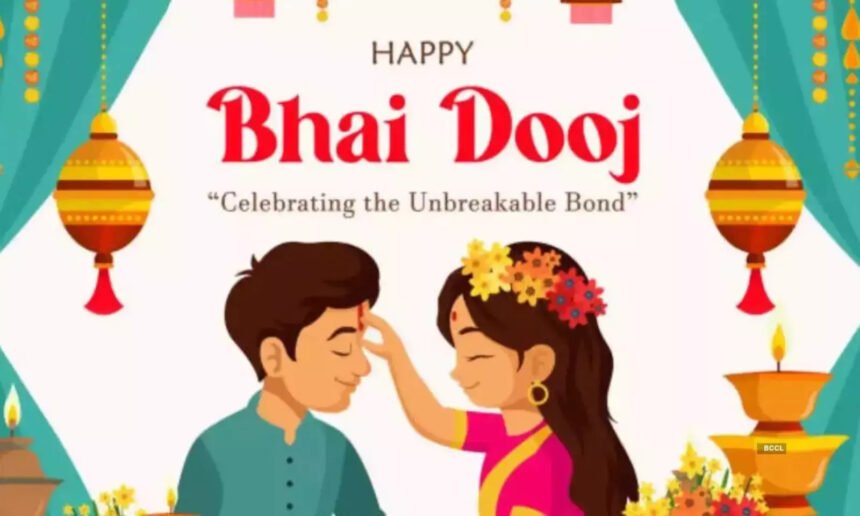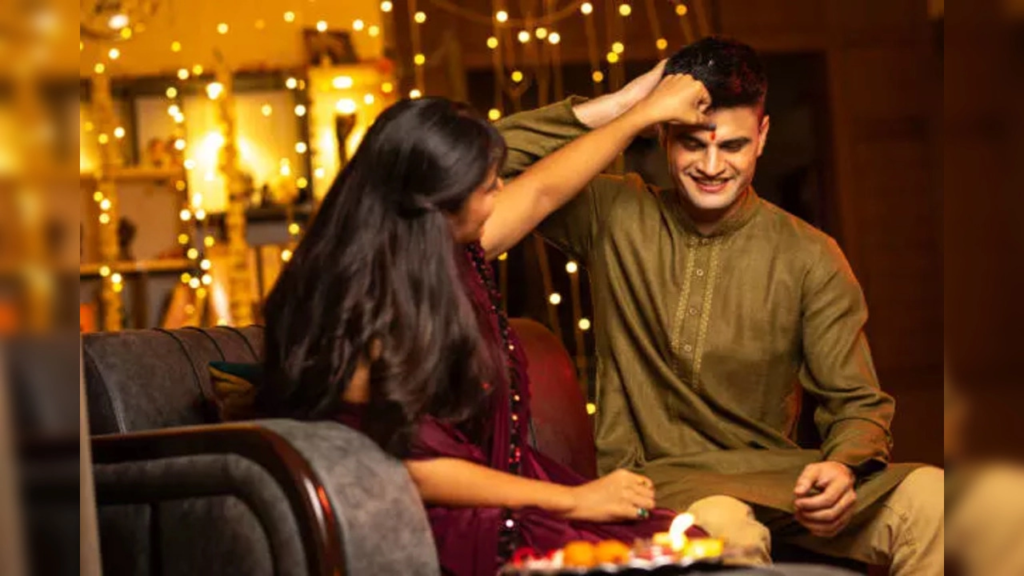Bhai Dooj2024 , also known as Bhai Phota or Bhai Tika, is a cherished Indian festival that honors the special bond between brothers and sisters. Celebrated on the second day after Diwali, it symbolizes love, protection, and blessings between siblings. This year, Bhai Dooj falls on November 3, 2024, and holds great significance in Hindu traditions. To make the celebration even more auspicious, performing the rituals at the correct Shubh Muhurat is essential. Let’s dive into the puja details, the required items, and the precise timings to perform each step of this heartfelt ritual.
What is Bhai Dooj?
Bhai Dooj is a day when sisters pray for their brothers’ long lives and happiness by performing a tilak ceremony. In return, brothers vow to protect their sisters, strengthening their lifelong bond. The festival has various names and forms across India—such as Bhai Tika in Nepal and Bhai Phota in Bengal—but the sentiment remains the same. It’s a celebration of sibling love, loaded with rituals, laughter, and heartfelt exchanges.
The Importance of Shubh Muhurat on Bhai Dooj
Timing is everything in traditional Hindu festivals, and Bhai Dooj is no exception. Performing the rituals during the Shubh Muhurat is believed to amplify the blessings and protection invoked during the ceremony. This year, Bhai Dooj falls on the Dwitiya Tithi of the Shukla Paksha in Kartika month, which began on November 2, 2024, at 8:22 PM and will conclude on November 3, 2024, at 11:06 PM.
Tilak Muhurat for Bhai Dooj 2024
The ideal time to perform the tilak on your brother’s forehead is between 1:10 PM to 3:22 PM on November 3, 2024. Within this window, sisters can conduct the tilak ceremony with all the traditional rituals to ensure prosperity and protection for their brothers.
Essential Items for the Bhai Dooj Thali (Puja Samagri)
A well-prepared thali or platter is a central part of the Bhai Dooj ritual. Sisters carefully arrange various items on this thali, each symbolizing blessings for their brothers. Here’s what you’ll need:
- Vermilion (Sindoor): To apply tilak on the brother’s forehead.
- Flowers: A symbol of purity and beauty.
- Rice Grains: Represent abundance and prosperity.
- Betel Nut (Supari) and Betel Leaves: Represent longevity and good fortune.
- Silver Coin: Symbolizes wealth and success.
- Coconut: Represents auspicious beginnings.
- Garland of Flowers: Adds beauty and fragrance to the ritual.
- Sweets: To sweeten the bond between siblings.
- Sacred Thread (Kalava): For blessings and protection.
- Sacred Grass (Dhoob) and Banana: Traditional items that enhance the ritual’s sanctity.
Step-by-Step Guide to the Bhai Dooj Puja Vidhi
To perform the Bhai Dooj ritual, it’s essential to follow these steps with devotion and love:
- Preparation and Prayer: Begin the day with a bath and offer prayers to your chosen deity, often Lord Vishnu or Lord Ganesh. Invoke blessings for a successful and meaningful ceremony.
- Arranging the Thali: Carefully arrange the items listed above on the thali. The thali is an important aspect of the ritual and should be prepared with love and attention to detail.
- Applying the Tilak: Start by applying a paste of vermilion and rice grains on your brother’s hands. Place five betel leaves, a betel nut, and a silver coin on his hands.
- Tilak on the Forehead: Apply a tilak on your brother’s forehead while silently praying for his long life, success, and happiness.
- Sweetening the Bond: Offer sweets to your brother as a gesture of love, symbolizing a sweet future.
- Performing the Aarti: With the diya in the thali, perform an aarti for your brother, moving the thali in a circular motion around him. This ritual invokes divine blessings for his well-being.
- Sharing a Meal and Gifts: Many brothers then visit their sisters’ homes for a shared meal. They also bring gifts as tokens of appreciation and love, adding joy to the celebration.
Regional Variations: Bhai Tika and Bhai Phota
While Bhai Dooj is widely celebrated in India, the customs and rituals vary across regions:
- Bhai Tika (Nepal): In Nepal, Bhai Tika involves an elaborate prayer ceremony, where sisters chant mantras for their brothers’ prosperity and longevity.
- Bhai Phota (Bengal): In Bengal, sisters apply a tilak with sandalwood paste on their brothers’ foreheads and perform an aarti to protect them from evil.
Significance of the Tilak in Bhai Dooj
The tilak is a sacred mark that symbolizes protection and goodwill. By applying the tilak, sisters are believed to shield their brothers from negative influences. It also acts as a blessing for strength and success, strengthening the sibling bond.
Popular Wishes and Messages for Bhai Dooj 2024
If you’re looking to send some heartfelt messages to your brother, here are a few popular ones:
- “To my dearest brother, you’re my first friend and lifelong protector. Happy Bhai Dooj!”
- “May this Bhai Dooj bring you all the success and happiness in the world. Love you always, dear brother!”
- “Your love and support make my world a brighter place. Here’s to many more memories together. Happy Bhai Dooj!”
How to Celebrate Bhai Dooj’s on Social Media
Sharing Bhai Dooj images for WhatsApp and other social media platforms has become a popular way to spread the festive spirit. Many people also use unique hashtags, post personalized messages, and share photos from their ceremonies to connect with loved ones.
Bhai Dooj in Mythology
According to Hindu mythology, Bhai Dooj has ancient roots:
- Story of Yama and Yamuna: The legend says that on this day, Yamuna invited her brother Yama (the God of Death) to her home, where she welcomed him with a tilak ceremony. Moved by her love, Yama blessed her with prosperity and declared that any brother who receives a tilak from his sister on this day will be protected from untimely death.
- Story of Krishna and Subhadra: Another legend speaks of Lord Krishna visiting his sister Subhadra after defeating the demon Narakasura. She welcomed him with a tilak, symbolizing her love and relief for his safety.
Modern Celebrations of Bhai Dooj’s
While the essence of Bhai Dooj remains rooted in tradition, the celebrations have evolved with time. Today, many families celebrate virtually or through social media when they can’t meet in person. Bhai Dooj wishes for brother often include sending personalized digital cards, video calls, and sharing bhagini hastha bhojanam (sibling meals) online.
Conclusion
Bhai Dooj 2024 is a reminder of the timeless connection that siblings share. Beyond rituals and traditions, this festival is about the love and memories that bind brothers and sisters together. Whether you’re celebrating in person or virtually, may this Bhai Dooj bring you closer to your siblings and strengthen the bond of love and protection.
Read More: SaaS Meaning: Everything You Need to Know About Software as a Service
Final Thoughts
As you gear up for Bhai Dooj 2024, remember that it’s the emotions and love that make this festival special. Prepare your thali with devotion, follow the Shubh Muhurat, and enjoy the day with your family. Here’s wishing you a beautiful and blessed Bhai Dooj!










